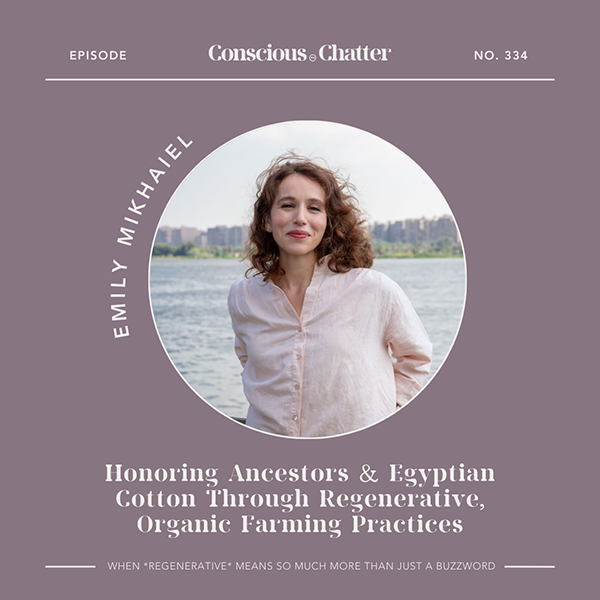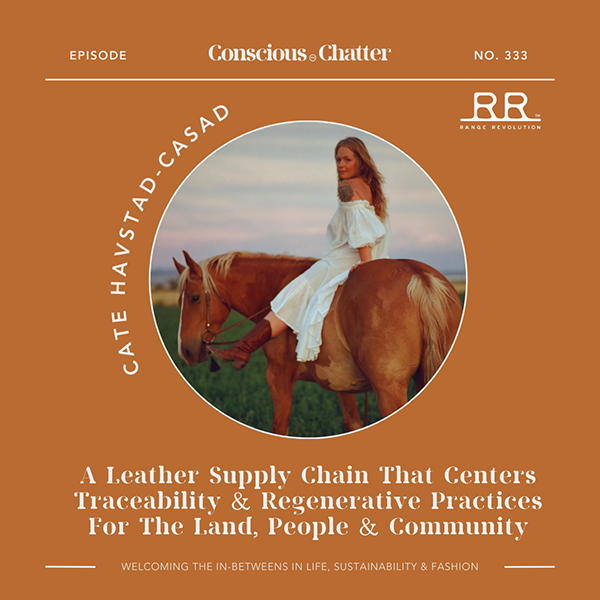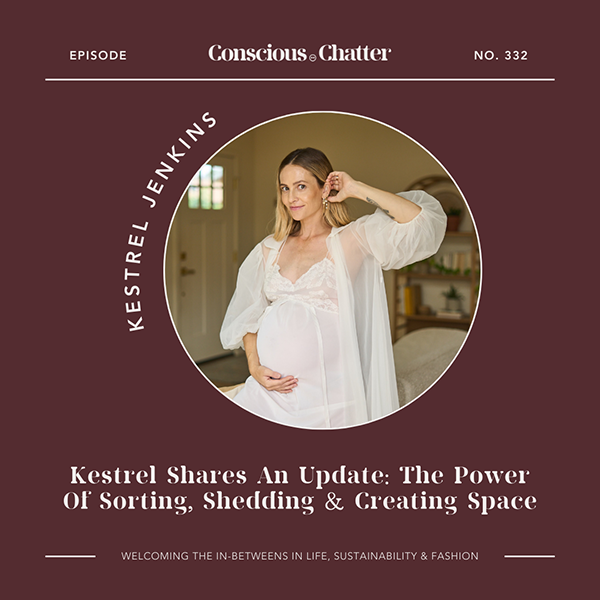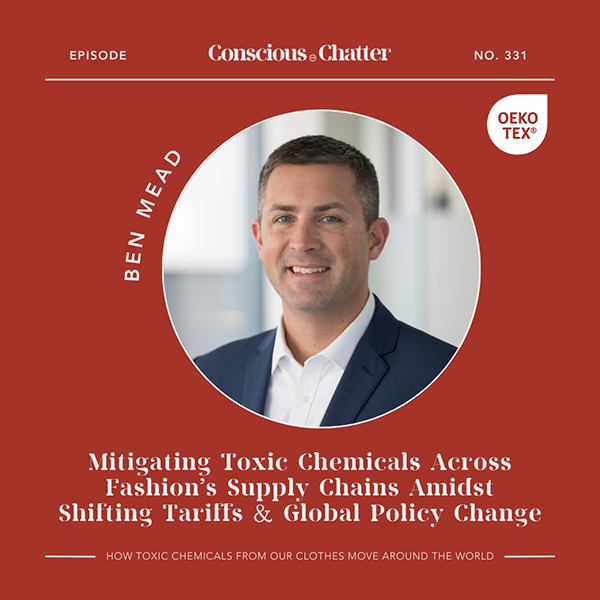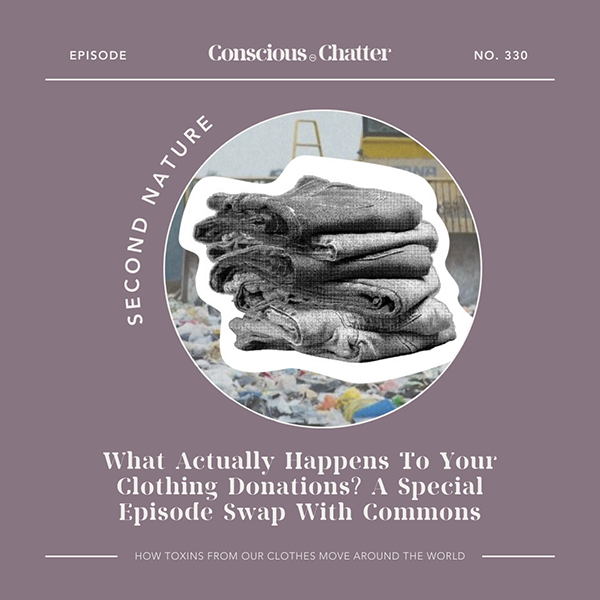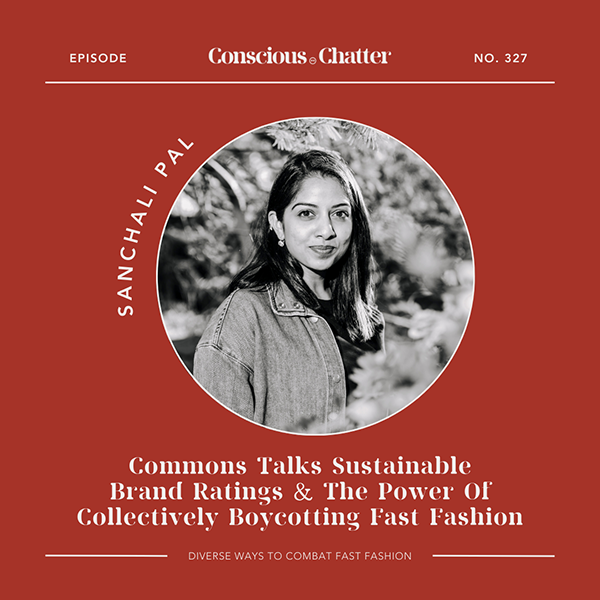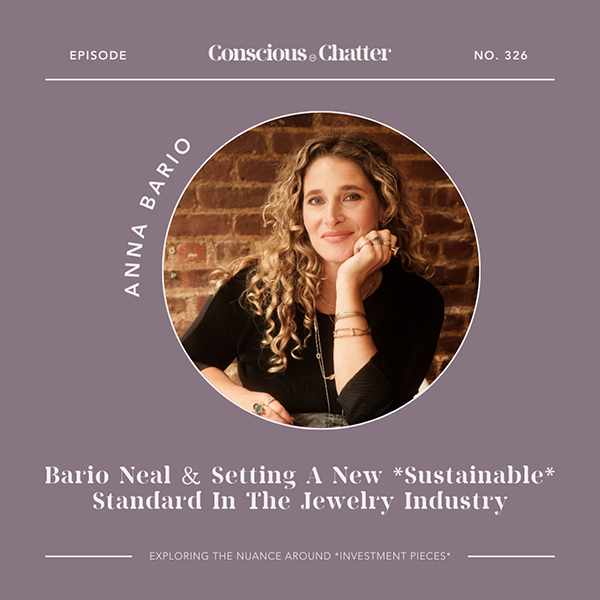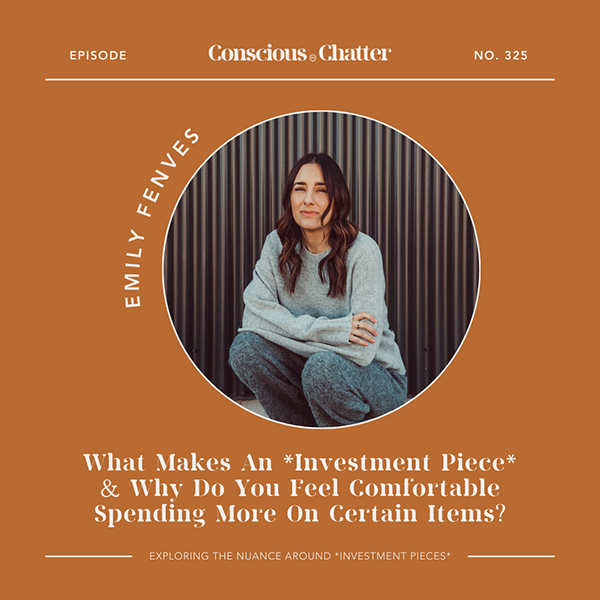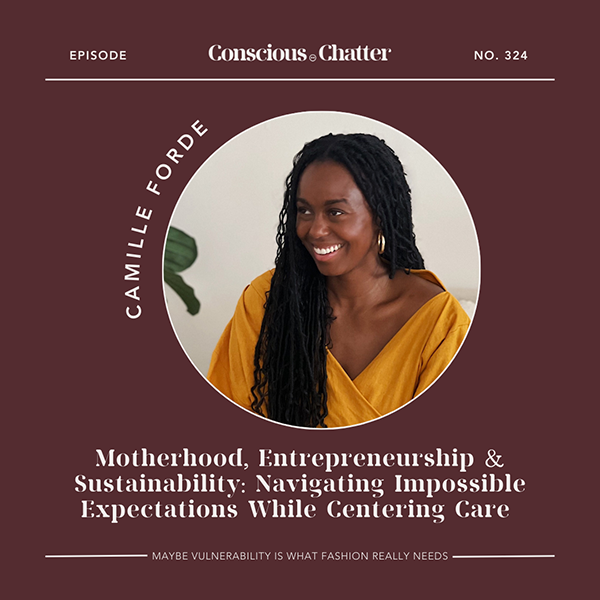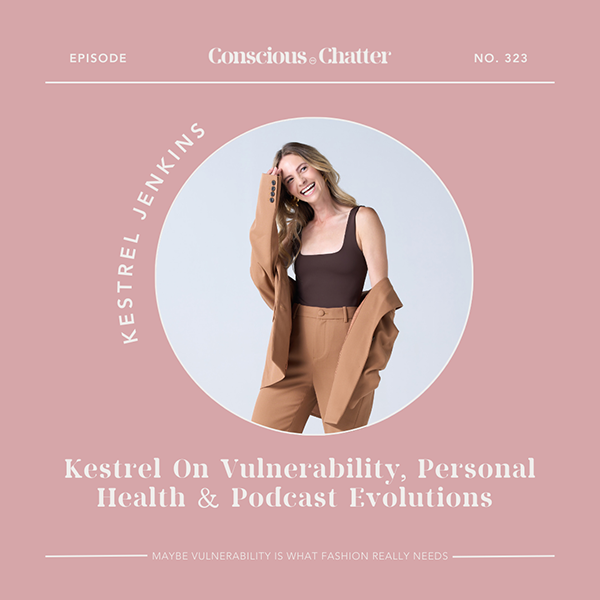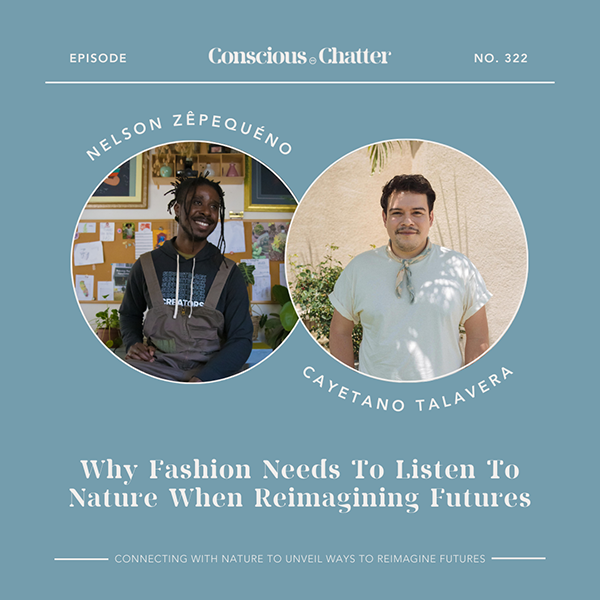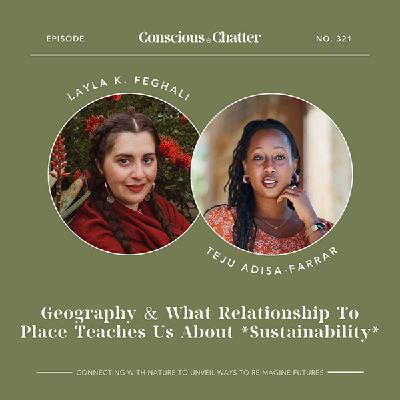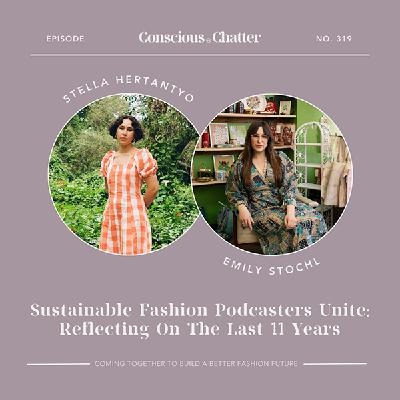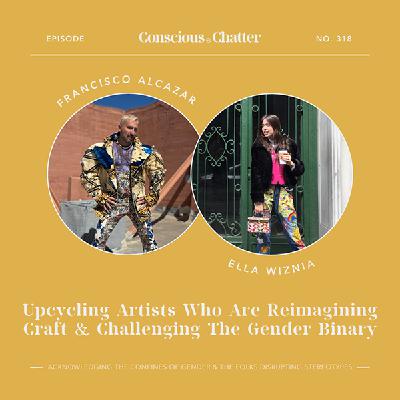Discover Conscious Chatter
Conscious Chatter

Conscious Chatter
Author: Kestrel Jenkins
Subscribed: 513Played: 10,612Subscribe
Share
© Conscious Chatter
Description
The first global sustainable fashion podcast, Conscious Chatter opens the door to conversations about our clothing + the layers of stories, meaning and potential impact connected to what we wear. Hosted by Kestrel Jenkins, Conscious Chatter tackles nuanced topics that intersect with sustainability, fashion, systems of oppression, health, and wellbeing through a curiosity-driven lens. Through deep dive monthly themes, the focus is on making the conversation more circular.
336 Episodes
Reverse
In Episode 334, Kestrel welcomes Emily Mikhaiel, the cofounder and creative director of Nazeerah, to the show. A clothing brand inspired by the legacy of her grandmother, Nazeerah supports organic and regenerative farming practices to honor Egyptian cotton, and produces locally in Egypt to maintain direct relationships with their suppliers and reduce their carbon footprint. “There really wasn't waste while my father was growing up. Everything was either composted or if it was metal, it was recycled or reused or repurposed. If a garment was no longer wearable, they'd cut it up into strips and weave carpets out of it. And once the carpet was no longer usable, they'd cut it up again and compost it. So using that knowledge and thinking, you know, as a society, we've existed without plastics for millennia. Why can't we return to that and draw inspiration from that in our design?” -Emily SEPTEMBER THEME —WHEN *REGENERATIVE* MEANS SO MUCH MORE THAN JUST A BUZZWORD This week’s episode is focused largely on a regenerative approach to making clothes – one that includes thinking about the end of life of the garment at the design process, where organic cotton farming is centered, not only to help maintain soil health, but also to enhance biodiversity and restore carbon to the soil, and where local production is prioritized. Without sounding like a broken record, it’s important to acknowledge how this word – regenerative – has undoubtedly become another buzzword that’s taken fashion by storm. We’ve seen countless brands integrate it into their marketing messaging, and it’s becoming more and more utilized across the space as the “new way” to talk about building a more sustainable brand. HOWEVER – it’s very key to note that regenerative is by no means a new concept. As we’ve touched on in past episodes, it is rooted in Indigenous knowledge, in traditional ways of farming and ancestral ways of growing plants and being in conversion with the Earth. This week’s guest has deep family ties to cotton and garment making in Egypt. As she shares with us, Egypt has a unique history connected to cotton farming that for generations, was intrinsically linked to the natural rhythms of the Nile River. Through her brand, she is not only honoring her ancestors’ connection to the land, but also supporting farmers who are reclaiming what regenerative cotton farming can look like today. Nazeerah Website Follow Nazeerah on Instagram
In Episode 333, Kestrel welcomes Cate Havstad-Casad, a designer, entrepreneur, and first-generation regenerative rancher, to the show. Cate’s work as a designer and land steward has evolved a great deal since she founded Havstad Hat Company in 2014. Today she manages Casad Family Farms with her husband, while building Range Revolution, a luxury leather goods brand focused on using 100% American, regeneratively sourced hides. “I love the idea of having things forever. I love the idea of a great leather boot being resoled again and again. My work in hats, I'm like the anti-growth capitalist. I'm like, you should have two hats, maybe three and that should be it for your whole life and you send it back to me and I will re-block it and clean it up and reshape it for you. That is the world of craft that I come from and so I bring that ethos to this work with Range Revolution and leathers.” -Cate AUGUST THEME — WELCOMING THE IN-BETWEENS IN LIFE, SUSTAINABILITY & FASHION This week’s episode touches on a discourse that often fuels a lot of really intense reactions. I remember moderating a panel discussion about it in Berlin during fashion week that got very heated, and even recently, I hosted an Earth Day event in San Francisco, where the conversation suddenly got intense when this topic arose. If you guessed it – I’m talking about the oh-so-familiar LEATHER debate. There’s a recurring dispute in the sustainability and fashion space that pins animal-based leather against vegan leather. It’s often very this vs that oriented, and focuses on claiming which is quote unquote more “sustainable” than the other. A lot of the time, things get heated because leather is intrinsically linked to peoples’ belief systems and values, which can leave very little space for the in-between. And I totally get where that passion stems from. At the same time, if you’ve been listening to Conscious Chatter over the years, you know there are no simple answers when it comes to the complexities of making products. And I don’t think there is ever only one solution – we need to discover multifaceted approaches, considering the challenges we face with the climate crisis. From her lens as a craftsperson, designer and regenerative rancher, this week’s guest is dedicated to rethinking waste in the animal agriculture space. One significant stat we learn from her is that – almost 5 million hides are wasted or thrown away annually in the United States alone. *source: Agriculture Utilization Research Institute With a mindset that “the most radical fibers are the ones that already exist” – she is pushing to disrupt the leather industry. For her, it’s all about centering traceability, rethinking waste, and expanding the meaning of regenerative to not only include the land health, but also the health and wellbeing of the surrounding community. “We don’t have regenerative outcomes on land if the people working within the systems. whether it be the land stewards or the people within the community that support those land stewards — if the community dynamics, if the economic dynamics are not also regenerative.” (15:40) Range Revolution Website Follow Cate on Instagram Follow Range Revolution on Instagram This week’s episode is brought to you by Range Revolution. Enjoy 15% off at RangeRevolution.com with code CHATTER.
Episode 332 features Kestrel (just me!) in the second-ever solo episode of the show. With a focus on Kestrel’s reemergence after having her second child, she shares some of the things that have been on her mind during this postpartum era, the power of sorting, what “release” has meant to her over this last year, what she’s shedding and what’s she’s embracing. It’s very personal, raw and vulnerable — one of the ways Kestrel always loves to connect with you all. “Maybe this whole episode is sounding disconnected from what you generally hear in the sustainability and fashion realm. But – if you’ve been around for a while, you know that I am not exactly the voice of the typical narrative. I like to push beyond binaries. I want to explore the nuances. I don’t want to put people, things or ideas into boxes. These in-betweens are where SO MUCH can thrive, if we let it and give it space to breathe.” -Kestrel August THEME — WELCOMING THE IN-BETWEENS IN LIFE, SUSTAINABILITY & FASHION When I started the show back in 2016, I never thought I would be into doing solo episodes. My mind was clear that I wanted to welcome guests onto the show and to really focus on learning, listening and sharing multifaceted ideas from solutionists working at the intersections of fashion and sustainability. And that general intention hasn’t wavered. BUT surprisingly, in moments of change or transition, I have felt pulled to connect with you all on my own – just me and my thoughts. It gives me the chance to connect in a really honest, personal, and vulnerable way. It’s maybe weird, but I almost feel like having a podcast – a space to dump my thoughts, musings, learnings, challenges – it’s really cathartic, and at times, healing as well. Throughout this brief episode, you’ll hear: + Welcoming a new baby + Honoring the mothers in Gaza + Postpartum shifts — the importance of sorting, releasing, and closing doors + Creating space — what prioritizing looks like with two kids + Rooting more deeply into my truth — a new endeavor & a book project Links & quotes from the show: Gaza on my mind — IG post by Evelyn Escobar (@evelynnworld) that Kestrel highlights Organizations and resources to support mothers and families in Gaza — The Sameer Project Healing Our Homeland Free Kitchen Gaza We Feed Gaza Heal Palestine Medical Aid For Palestine USA For UNFP Anera “THANK YOU FOR BEING HERE. The fact that we can have this space to share openly about so many things that make us human is an absolute blessing. When I initially started this show to simply talk about fashion and sustainability – I never imagined I would learn so much about who I am and who I want to be in the world. Turns out – sustainability starts with each one of us. Looking in the mirror and getting clear about ourselves, tuning into our communities that surround us, leading with curiosity and care, and above all – thoughtfully questioning everything along the way.” Follow Kestrel (Conscious Chatter) on Instagram
In Episode 331, Kestrel welcomes Ben Mead, the Managing Director of Hohenstein Institute America, to the show. In Ben’s role, he serves as the company’s liaison with government agencies, industry collaborations and trade associations, and he also oversees OEKO-TEX® responsibilities for the U.S. “You can’t make any real good decision around chemistry or you know how a product is made, if you don’t know who’s making it and what’s going into it.” -Ben MAY THEME — HOW TOXIC CHEMICALS FROM OUR CLOTHES MOVE AROUND THE WORLD It is a tumultuous time when it comes to policy, and policy that is specifically impacting global supply chains. Not only immediately, when we think about tariffs and the unclear, yet very real, impacts they will have on fashion businesses, but also legislation across the world that has either passed or is on the table, and requires fashion companies to be more tuned in to the actual impacts of their supply chains. These bills have without a doubt brought fear and stress to many fashion brands, because if they haven’t been mapping their supply chains previously, it’s going to prove very difficult for them to comply with some of these new requirements. What should brands know about these changing regulations? How can they navigate the shifting landscape, and what should they be doing now? As this week’s guest reminds us, there’s no one-size-fits-all answer, but there are things brands can be doing to rethink their supply chains and expand their approach to sustainability. OEKO-TEX® Website OEKO-TEX® MADE IN GREEN OEKO-TEX® Label Check Follow OEKO-TEX® on Instagram This week's episode is brought to you by OEKO-TEX®. For over 30 years, OEKO-TEX® has set global standards for chemical safety, responsible production, and supply chain transparency, ensuring that textiles and leather products are tested for harmful substances. Learn more about their MADE IN GREEN label here >
This episode is a little different than what you’re used to, as it’s a special swap with Commons and their Second Nature podcast. It’s an amazing listen and I’m stoked to share it with y’all! “I think this is inspiring people to move away from being passive consumers to instead becoming stewards of their belongings and have that sense of responsibility and it goes beyond this individual action…For us, democratizing repair isn't just a luxury or a trend, it's something essential to creating this future where sustainability and equity guide the way forward.” -Sumaq Alvarado del Aguida, Suay Sew Shop This month’s theme is – HOW TOXIC CHEMICALS FROM OUR CLOTHES MOVE AROUND THE WORLD. This episode by Second Nature gets into the layers around donated clothing, how BIG of an issue it is, and how global it truly is. From talking about the recent devastating fire in Kantamanto Market in Accra, Ghana, to the onslaught of clothing donations that overwhelmed facilities in Los Angeles after the wildfires in January this year, this episode explores some interested parallels and disturbing realities around the low quality of so much of the clothing that ends up in the donation cycle, as well as the harmful impacts that toxins within those clothes can have on the communities where they land. You’ll hear from Sumaq of Suay Sew Shop in LA on the excess of crappy clothing that was donated to them amidst the wildfires, and how they are working to get creative with those textiles. One thing I want to highlight is how Sumaq shares that we need to become “stewards of our belongings”. Passing it over to Katelan, the host of Second Nature, who will share more with you in this special episode! Second Nature Episode Follow Second Nature on Instagram
In Episode 329, Kestrel welcomes Jennine Jacob, a personal stylist and Instagram phenom, to the show. You may know Jennine from viral videos that explore the many layers of nuance connected to the power of finding your own style. “Anytime I see people quote unquote dressing for their body type, those outfits that look good, they can all be explained through style principles. The rule of thirds, contrast, proportion, texture, color theory. So why do we have to attach a value to a person's body shape when that's not even necessary? I really want to call into question why we use certain language because there's a lot of dismissal of visual language not just in fashion but also in the arts and architecture, and in the spaces that we move that have tremendous impact in how we navigate the world.” -Jennine MARCH THEME — PERSONAL STYLE IS SO MUCH MORE THAN *VANITY* This month, we’re shifting the narrative a bit toward the conversation around style. I recently did a post on Instagram about why I post daily outfits and how it’s not about vanity, and instead – it’s about storytelling, sustainability and branding. It resonated so much with folks and made me feel optimistic amidst a time that can be pretty gloomy lately. I talked about the power of knowing the stories connected to your garments and how that storytelling can come through in the way you wear them. I talked about how when you have intimate connections with your garments, you tend to take care of them so they last longer. I talked about how identifying your personal style is a key part of building your brand, and honing in on the colors you consistently wear can play into determining or realizing your aligned visual identity. I even mentioned the whole “fashion is frivolous” annoying narrative, and how it’s totally ridiculous considering how much your clothing choices do actually truly matter. Turns out, that’s one of the many topics we crack open with this week’s guest. “Is The Internet Messing With Your Style?”, IG reel Kestrel mentions “The Power Dynamics Of Comfort”, IG reel Kestrel mentions “Quiet Luxury Helps The Oligarchy”, IG reel Jennine mentions “Focus in on not just how you want to look, but what you want to say with your style, and why you want to say it.” (40:06) -Jennine Jennine’s Website Follow Jennine on Instagram
In Episode 328, Kestrel welcomes Dana Zhaxylykova, an environmental scientist & microplastics researcher, to the show. Originally from Kazakhstan, Dana is currently based in Germany — through her Instagram platform, she shares practical and actionable tips about microplastics through a scientific lens. “As a scientist, I want to assure you that every little action in avoiding plastic, it can have an impact. And as scientists and as a scientific community, we expect people, not only the governments and corporations (they have a huge responsibility, of course), but we as people, we also can have an impact as individuals, we can help these problems to get solved faster.”-Dana This month, we’re focusing on diverse ways to combat fast fashion. I don’t know about you, but whenever I think of fast fashion, my brain automatically goes to issues around MICROPLASTICS. Considering that over 60% of global fiber production is synthetic materials – derived from fossil fuels – it’s hard not to make that connection, especially given some of the intimate experiences I’ve had watching scientists from 5 Gyres literally collect microplastics from the water and air around us, and hear them talk about how so many of the microplastics they collect have come from fabric and clothing. As this week’s guest highlights, with nylon, polyester and acrylic fabrics flooding the fast fashion market, these fibers are actually releasing microplastics in every stage of the process – from production, to wearing the garments, to washing and drying them. Basically, there are microplastics being shed into our environment from every single stage of a fast fashion garment’s lifecycle. That feels overwhelming, I know, but I love how this week’s guest really puts things into perspective, not only from a scientific lens, but also from a practical hands-on point of view, offering us suggestions on the things we can actually control, when it comes to microplastics in our lives. “Seasonal variation and removal of microplastics in a central Asian urban wastewater treatment plant”, Dana’s research paper “Effect of microplastics deposition on human lung airways: A review with computational benefits and challenges”, paper Dana mentions “Environmental exposure to microplastics: an overview on possible human health effects”, paper Dana mentions “Effects of microplastic exposure on human digestive, reproductive, and respiratory health: a rapid systemic review”, paper Dana mentions “Polystyrene microplastics exacerbate systemic inflammation in high-fat diet-induced obesity”, paper Dana mentions
In Episode 327, Kestrel welcomes Sanchali Pal, founder and CEO of Commons, an app that rewards you for living and spending sustainably. On Commons’ app, you can get rewarded for shopping sustainable brands and for taking climate actions like thrifting, taking public transportation or eating plant-based. “When people think about the actions they can take that are sustainable, the most obvious ones are things like flying less or recycling or eating more plant-based. People don't always think about their clothing habits, but I think that's really changing with the conversation around fast fashion. I mean, the fashion industry has a greater environmental impact than the airline industry. It's like two to three times as much, which is pretty crazy. And so it is really exciting to start to see that conversation happen and start to think through what part we can all play in shifting that industry together.” -Sanchali FEBRUARY THEME — DIVERSE WAYS TO COMBAT FAST FASHION This week’s episode is brought to you in collaboration with Commons. As a cohost of their Anti Fast Fashion Challenge, I’m stoked to share more about how you can get involved to boycott (in many different ways) harmful fast fashion brands this month. While it can be challenging to fathom, especially being so deep within the sustainability and fashion conversation, fast fashion is booming. From the H&Ms and Zaras, to the more recent addition of ultra fast fashion brands like Shein and Temu, our culture is addicted to fast fashion. From the cheap prices to the convenience factor to the instant gratification, the allure of fast fashion is real. But as many of you know, buying fast fashion comes with an intense environmental and human impact. Fast fashion aligns itself with disposability and waste, boasting crazy low prices. The materials are predominantly synthetic and often lose their shape after a couple washes. The synthetic materials shed loads of microplastics into the environment. Garment workers face exploitation and non-livable wages. All the while, social media and marketing continue to drive us to think we need another new piece of clothing to stay relevant. It’s a lot. And that’s why I am so excited for this conversation – and to be cohosting this month’s Anti Fast Fashion Challenge. A way for us all to collectively come together to challenge that intense urge to buy another cheap item, and instead – not shop, mend something, get something tailored, shop secondhand, or invest in a brand that centers sustainability. “Our spending is the best data source we have on our emissions.” (14:26) -Sanchali “It Starts At Home?” — research Sanchali mentions on household spending Join The Anti Fast Fashion Challenge Commons Sustainable Spending Tool / Brand Ratings How Commons Rates Brands Commons Website Listen To The Second Nature Podcast Follow Commons on Instagram
In Episode 326, Kestrel welcomes Anna Bario, the cofounder of Bario Neal, to the show. Bario Neal creates stunning jewelry while being committed to respecting human rights and environmental sustainability. Anna cofounded the brand alongside Page Neal, in 2008, with an interest in bringing sustainability into the discourse surrounding creativity, fine jewelry and craft. An exceptional designer and also a specialist in responsible gold and gemstone sourcing, Anna’s work in sustainable initiatives and social impacts defines the framework for Bario Neal’s ethical jewelry roadmap. “I think [for] jewelry especially, the investment question becomes entangled with presentation … we also see that culturally come through jewelry trends. Just like in fashion, pant legs get shifted and there’s so many ways we could interpret that as a reflection of the culture. And in jewelry, after the 2008 recession, jewelry got really small. Part of that was because of what people could afford, but also it was sort of like socially, what do we want to present?”-Anna JANUARY THEME — EXPLORING THE NUANCE AROUND INVESTMENT PIECES This episode is part of a partnership with Bario Neal. One of the pieces included in this collab was a redesign of my wedding and engagement rings. If you’re wondering why I would redesign my wedding rings? They felt a little too traditional for my aesthetic, especially as I’ve matured, and also – the prong setting of the lab grown diamond just wasn’t practical – it was always getting caught doing all the things connected to mom life. In this episode, we not only get an intimate look behind the scenes of what building an ethical jewelry roadmap means to Bario Neal, we also dive deeper into this month’s theme of investment pieces. One thing Anna brings up that is such an important and often left out layer of this discussion is how “investment” in the jewelry space can easily become entangled with the performance of economic resources and privilege. In jewelry, and other areas of fashion as well, this can mean the designs showcase a blatant reflection of the economic realities around us at any given time. For example, when the economy isn’t doing well, often, jewelry trends will reflect that in favoring smaller stones and more quote unquote modest styles. And even if folks have the economic means to choose something with a higher price point or bigger stones, they may choose not to, based on what they feel comfortable presenting to the world in that moment of time. We unpack this and more in this special jewelry-focused episode. Turning To Stone, book by geologist Marcia Bjornerud that Anna mentions Mercury Free Mining Website Ethical Methalsmiths Website Bario Neal’s Website Follow Bario Neal On Instagram This week’s episode is brought to you in partnership with Bario Neal, a jewelry industry leader in ethical sourcing and progressive manufacturing. GET 15% OFF PERSONALIZED JEWELRY WITH CODE CONSCIOUSCHATTER15 AT BARIO-NEAL.COM
In Episode 325, Kestrel welcomes Emily Fenves, the founder of lander line - a platform she created in September 2021 - after feeling burnt out with her own consumption habits. As a regular shopper, Emily found herself spending an exhaustive amount of time browsing, buying, returning, and purging. She embarked on a journey to learn more about the “why” behind her overconsumption, and decided to help others do the same. “I think a lot of people assume that investment pieces mean luxury. For me, specifically, I always think about – can I pass this down to my daughter? Investment pieces can be secondhand, too. Whether I’m shopping new or secondhand, I’m always asking myself that question – is this something I can pass down to her?” -Emily JANUARY THEME — EXPLORING THE NUANCE AROUND *INVESTMENT PIECES* This month, we’re going all in on – investment pieces. What does that really mean? Well, that’s one of the aspects we unpack. But if you google around and start diving into the discussion online, you’ll find a lot of people talking about things like: LONGEVITY, JUSTIFYING HIGHER TICKET ITEMS, HIGHER QUALITY, HIGHER COSTS, and EVERGREEN STYLES. We touch on cost per wear, the idea of fewer better things, and recommendations when you’re searching for investment pieces. It’s also personal – so remember to take that into account as you listen to this week’s guest. What you deem an investment piece may not necessarily be what someone else identifies as an investment piece – and to me, that’s some of the fun of it. Speaking of this week’s guest – she self identifies as a former overconsumer-turned-fair-fashion-advocate who loves secondhand and influencing others to quit fast fashion. RealReal’s 2024 Resale Report lander line’s Substack Follow Emily on Instagram
Episode 324, Kestrel welcomes Camille Forde, a mother and entrepreneur working at the intersection of business, sustainability, and community-centered solutions, to the show. With over a decade of experience, Camille has led corporate responsibility efforts at top professional services firms, earned an MBA from UC Berkeley with a focus on sustainable business, and spearheaded seller and brand partnerships at one of the largest fashion resale platforms. As a mother of two, Camille is deeply committed to building a more equitable and sustainable future that prioritizes community care. “Vulnerability, at least for me, it’s a practice. It’s not: you’re vulnerable once, and then you’re done. I’ve had to make being vulnerable a regular practice that I chase even though I don’t want to all the time.” -Camille OCTOBER THEME — MAYBE VULNERABILITY IS WHAT FASHION REALLY NEEDS Last week, I got vulnerable. I shared a lot about my personal story over the last year – the challenges I’ve faced, personally with my health, professionally, financially, with continuing to push an independent media platform forward – I’d say I shared a lot in a short amount of time. It blew me away to see the response – so many folks reached out, shared their personal challenges, and were vulnerable with me about things they’ve faced. I don’t know – it felt like it opened a bit of a portal to somewhere new. To a more connected realm, where we could actually be honest with each other. A place where we could not only talk about transparency being important in supply chains and messaging, but also in our personal lives and realities. It felt big. And I want to thank you for allowing that real emotion in, and sharing your own vulnerabilities – because as this week’s guest reminds us, so often what we receive with vulnerability is GROWTH (not in production volume, but in ourselves). This episode is really about a lot of challenges I’ve faced, mental struggles I have grappled with, and questions I’ve asked myself while working at the intersections of caring for people and the planet, and caring for my own child. When I was thinking about this episode idea as a way to build on this vulnerability discussion, one mom stood out immediately. I thought – I want to talk to Camille about this - it’s who I want to hear from, who I want to learn from, and I just felt like she would have a lot of valuable insight into these crossovers. Turns out, Camille went beyond. This episode is about sustainability, but not your typical approach to that conversation. It’s about caring for yourself, for your family, for your community, while building things that center care. “The perfectionism and shaming that happens both in motherhood or just parenthood and the sustainability space — it’s just beyond.” -Camille “The reality is we’re not going to be perfect at any of it, but you know, if you’re not careful, there’s so much shame that can enter the conversation and really slow you down.” -Camille Camille’s Website Follow Camille on Instagram
Episode 323 features Kestrel (just me!) in the first-ever solo episode of the show. With a primary focus on vulnerability, Kestrel shares some of the rollercoasters she has faced personally over the last year (from health to finances), why she and Nat are parting ways when it comes to regularly hosting the show, the true costs of producing a podcast, as well as a question on whether performative vulnerability is what we are seeing too often from the industry. “To all of you interested in sustainable fashion or those of you who work in the industry - I want to ask you a question: are you ok!?”-Kestrel OCTOBER THEME — MAYBE VULNERABILITY IS WHAT FASHION REALLY NEEDS As you can see, Nat is not here. It’s super bittersweet, as doing the show hand-in-hand with someone I love, a best friend, and someone I admire deeply was truly magical. At the same time, realities happen, things shift, and sometimes what you anticipate doesn’t actually work out in the end. Being honest about the journey is, and always has been important to me. Nat is amazing as many of you already know. Moving forward, she won’t be cohosting with me on a regular basis, but she will jump back in as a guest or cohost on the show on and off down the line. I know this might be confusing for you since there have been a lot of shifts on and off throughout the year. First of all, thanks for sticking around, for caring deeply about the show, and believing in the potential power of change in the fashion space. This episode is all about vulnerability — I hope you can feel my hope to tear down some of the curtains that often separate us for connecting on a deeper level. Here’s what you'll hear from me: A bit about my person health stuff I’ve gone through over the last year Why it wasn’t possible for Nat and I to continue co-hosting together - hint, hint: independent media is hard A little insider info on what it costs to run a podcast Some musings on whether it’s possible for the sustainable fashion / fashion realm as a whole to get vulnerable and what that could look like
Episode 322 features Nelson ZêPequéno, a Ghanaian-American Artist and the founder of Black Men With Gardens and Sustain Creative, alongside Cayetano Talavera, a fiber artist, zero waste fashion designer, and the creative force behind HECHO BY CAYE. Through ‘Black Men With Gardens’, a digital and print publication, Nelson spotlights the connection Black and Brown communities cultivate with nature through agriculture and the arts. He further exploring cultural identity and environmental stewardship through his Los Angeles-based studio 'Sustain Creative', his current body of works offer a fresh perspective on sustainable contemporary design. Based in Los Angeles, Cayetano transforms foraged plants, homegrown flowers, insects, and even food waste into natural dyes, for his designs in the cocina de su mamá. His journey into the world of sustainable design was shaped by his humble upbringing, where he discovered the importance of resourcefulness and waste reduction. “Creativity is a way of looking at life differently, and by stepping outside of the way that we’re seeing life or our own perceptions and experimenting, we’re able to open up those new neural pathways and to reach these new places in life. For me specifically, I like to think that creativity is actually the solution not only to the mental health crisis that we’re all dealing with, but to actually the sustainability challenges that we’re facing. We need to embolden creativity in our culture and our communities so that people can look at the challenges that we have and come up with different ways of approaching it. We can’t essentially just fix the problems that we face now with the same thought processes that led us here, and the only way to get outside of that actually is to be creative.” -Nelson “The rhythmic movement that comes from making a craft — I find it to be very therapeutic. Whether it’s stirring a dye pot, painting strokes, I think also just the physical aspect that goes into being creative plays a role in ... it’s almost like you get so into what you’re creating that you kind of escape from your worries and anxieties for a bit. Once I start working, I totally forget whatever is going on around me, even if it’s for a split second. I am always encouraging people to just be creative; and don’t let the insecurities take over. I host natural dye workshops and a lot of adults tend to be like ‘but this isn’t for me’; ‘my tie dye bandana is going to come out super ugly’. And I’m like "‘no, everyone’s piece ends up looking really good and unique in their own way’. And so I think there’s fear that comes from being creative and I think people need to get over that hurdle first.” - Cayetano MAY THEME — CONNECTING WITH NATURE TO UNVEIL WAYS TO REIMAGINE FUTURES Narratives today often separate humans from nature – think of statements like “we need to protect nature” as if we aren’t a part of nature. But we are. Even though we often live and spend a lot of time inside buildings somewhat “separated” from nature, we are still intrinsically linked and woven into the natural world around us. As we have learned through so many of our guests this season, being connected to the world around us is not something new – it’s something that has been cultivated by Black and Brown Indigenous communities across the world through culture and tradition and a reverence for the ecosystems that we as humans are a part of. This week’s guests both interact with nature through their unique creative avenues – in very different yet overlapping ways. One works more directly with *fashion* through sewing and natural dyes, and the other not so directly with fashion but rather with plants and repurposing. The myriad of ideas they share remind us of the many things we can learn from nature (when we slow down enough to listen). What can fashion learn from nature to reimagine a better today and a more thoughtful tomorrow? Fashion folks, nature is calling, and it’s time we tune in … Links from the conversation: Hecho By Caye Website Sustaining Creative Website Fast Fashion AD on SNL that Kestrel mentions Follow Nelson on Instagram Follow Black Men With Gardens on Instagram Follow Cayetano on Instagram
Episode 321 features Teju Adisa-Farrar, the founder and co-creator of the Black Fiber & Textile Network and the creator/host of the Black Material Geographies podcast, alongside Layla K. Feghali, the founder of River Rose Remembrance, a Plantcestral & Ancestral Re-Membrance practitioner, cultural worker, author & story re-collector (archivist). Teju is currently the Director of Outreach & Programs for the Fibers Fund, and co-creates with members of BFTN. Layla’s book, The Land In Our Bones, showcases an exploration of the herbs & land-based medicines of Lebanon & Cana’an, highlighting the power of culture’s relationship with land. “I think of culture as a way of relating to your environment, including those around you, making sense & beliefs based on your environment, & creating a sense of a shared identity based on the place that you are in. With the creation of colonialism & the transatlantic slave trade, and this very globalized neoliberal world, now culture is less connected to a place & more connected to what and how we consume.” -Teju “I feel like that relational way of existing or of relating is kind of what ultimately yields or inspires I guess what folks would call a sustainable way of navigating things. Because it requires a conversation beyond the self and with the entirety of the living world that I dwell in and that I’m a part of and that I impact and that impact me, and the ways that they’re alive.” -Layla MAY THEME — Connecting With Nature To Unveil Ways To Reimagine Futures As the sustainability conversation continues to evolve, we often will hear mention of regionality, or the importance of thinking more locally in supply chains or manufacturing. While this is a great aspect to explore further, it only touches the surface of the depth connected to geography, location and place. This week’s guests each approach education and storytelling through place-oriented lenses. While they are each uniquely different, these geography-oriented avenues teach us so much about what is often missing from the conversation. As we’ve explored through various angles this season, culture is integral to sustainability. Our guests this week shed light on the many ways that culture can teach us about land, history and legacy. How understanding the land, its history and the cultures woven into it, can lead us toward restorative justice and regenerative practices. As one of our guests so beautifully writes in her book: “The real focus of sustainability should be to recenter these Indigenous technologies rooted in multigenerational relationships to place, and teach younger generations how to harvest in ways that ensure the life of these plants will not only continue but spread per this ancestral knowledge.” Links from the conversation: Teju’s Website Black Fiber & Textile Network River Rose Remembrance Website Follow Teju on Instagram Follow Layla on Instagram
Episode 320 features Wafa Ghnaim, a Senior Research Fellow at The Metropolitan Museum of Art, Curator for the Museum of the Palestinian People and Founder of The Tatreez Institute, alongside Dr. Tanveer Ahmed, a Senior Lecturer in Fashion and Race at Central Saint Martins and also Course Development Lead for MA Fashion and Anthropology at London College of Fashion. “Inherently, just by being Palestinian and by teaching about Palestinian life and history, and including oral history in my work as a foundational aspect of my research, I am threatening these kinds of structures, in and of itself. And so, simply my existence is resisting that colonialism and the normalization of destruction and death of Palestinian bodies.” -Wafa “Translating lots of decolonial thought around the canon and Eurocentrism and what shapes our ideas of art and design is really crucial to understand how we then deconstruct the canon. It’s not just a question about changing reading lists or to me, about representation and bringing in more Black and Brown academics into our institutions, although that is part of the equation. I think what we need to do and what I think is the most important role for me is to undue the harms that coloniality has done to our disciplines and within our institutions.” -Tanveer APRIL THEME — COMING TOGETHER TO BUILD A BETTER FASHION FUTURE Decolonizing fashion, intersectionality, identifying the knowledge holders, cultural inheritance and systems change were some of the key themes we explored in this week’s episode. We take a look at some of the areas that fashion educators are dismantling when it comes to heteronormative and Eurocentric views on fashion education and design. And how this knowledge can translate from the classroom or across cultural communities into practical ways. Building off of our last episode, we question – what are the biggest challenges we still face and how can we work toward more transformation? We learn from one of our guests that this focus and lens on decolonising fashion where marginalization and othering is built into the foundation, is very different to the offerings of cultural preservation, which holistically exists to share lived experience, pass over craft practice, history, culture and honor the hands and bodies of the people at the center of this. As our guest shares, what else is there if we cannot honor the people preserving culture. Fashion as it exists, still has a ways to go in embracing this at its roots, but our guests give us hope as they move through the world, sharing their wisdom and truth, and teaching us the meaning of how to be good custodians and stewards, so we can uphold this legacy with care and intention and continue to center Indigenous craft, culture and practice. Links from the conversation: Tatreez & Tea Website Tanveer’s Work Profile Follow Wafa (@tatreezandtea) on Instagram
Episode 319 features guests Stella Hertantyo, the co-host of the Conscious Style Podcast, alongside Emily Stochl, the host and creator of Pre-Loved Podcast. Stella also works as writer and communications coordinator, while Emily also works as the Vice President of Advocacy & Community Engagement at Remake. “There are so many painful roots when you look back at the way that certain dyes came about and you know, cotton farming — there are so many different legacies of colonialism that existed and still exist. But I also want to take the word painful out of that sentence and say that we have also learned to acknowledge the roots of sustainability because not all of them have pain at the center. And I think what I've learned with so much interest and joy is the different textile heritages that exist across the continent — from natural dyes to hand looming to the ways that people grow certain crops, and yeah, just different ways of expressing and using textiles as ways to archive and also to preserve culture. And there are so many people that do this incredible work and I think that that is a really, really important acknowledgment that I had to come to realize in my own journey.” -Stella “Labor rights are the foundation of what we know to be fashion activism in general, if we think back to the Triangle Shirtwaist Factory, which I know that something here in the United States, folks maybe learn about in school. This was another fashion industry-related disaster that led to a swath of movement-building around how we advocate for safer workplaces for people working inside the fashion industry. You know, roots to International Women’s Day, roots to some of the labor protections that we know and understand today, like the 40-hour work week. These are all things that if you look at the fashion industry from a history perspective, labor and the fashion industry, it is totally intertwined.” -Emily APRIL THEME — COMING TOGETHER TO BUILD A BETTER FASHION FUTURE Whether it’s legislation, science research & innovation, transformation in language, the storytelling tools & platforms in which we use to communicate, the evolution of definitions, the popularization of the second hand economy or labor rights advocacy – so much has changed within the sustainable fashion movement over the last decade. This week, we really put our new round table format to work. We dissect the sustainable fashion industry through a timeline of events, paying homage to Fashion Revolution Day – a movement that, in conjunction with many others, has brought more mobilization and change to the space. Join the four of us – all podcasters & storytellers – for this expansive breakdown. Links from the conversation: “What Is Extended Producer Responsibility in Textiles — and What’s Missing From Current Policies?”, article on Conscious Life & Style by Stella Become a Good Ancestor Podcast by Layla Saad (mentioned by Stella) Conscious Style Podcast Website Pre-Loved Podcast Website Follow Stella on Instagram Follow Conscious Style Podcast on Instagram Follow Emily on Instagram Follow Remake on Instagram
*DISCLAIMER — this episode features stories connected to eating disorders and sexual abuse. Episode 318 features guests Francisco Alcazar, a zero waste designer based in Los Angeles, California, alongside Ella Wiznia, the founder and designer of Series NY. Using his 25 years experience as a structural engineer, Francisco is leading the movement that promotes circularity in fashion, and expanding these principles to other disciplines, whilst celebrating the material stories of each textile and the individuality they represent. A New York based brand of ethically made genderless clothing and accessories, Series NY makes every piece in NY in partnership with skilled artisans who set their own rates using only pre-existing and sustainable materials. “What I like about upcycling is the freedom that it gives you. When you’re upcycling, you actually remix, rework, reuse. And in the process of doing that, the power is back to you. What I mean by that is when we go to a secondhand shop, all the clothes there are mixed up. You have the power to choose — there is no trend, there is no fashion. And the good thing is it’s hard because you have to deal with your inner ‘what you actually like’. And some people follow trends because the process of learning about you is hard. It’s easy to just conform and follow trends, you know, you go to magazines and copy a trend. You don’t have to actually learn about yourself anymore.” -Francisco “Fashion kind of seems to be one of the only forms of art that is quote unquote gendered in most peoples’ minds. I mean, you don’t go into an art gallery and say ‘oh no, this is for men; no, that piece is for a girl’ — you know, it’s just not how it’s done. Or architecture — ‘no, this building was for this these types of people’. We’re all able to experience them how we want.” -Ella MARCH THEME — Acknowledging The Confines of Gender & The Folks Disrupting Stereotypes The fashion industry can often be described as frivolous with labels, stereotypes and binaries boxing us in – telling us how we need to dress and what identities are deemed quote unquote ‘acceptable’, which can create spaces that are harmful, toxic and void of any sort of individuality and uniqueness – it can often be a place where difference in not celebrated but rather hidden. This week, our incredible guests share the power that upcycling has in being a paintbrush to the art you wish to create and see in the world - a world where the gender binary is challenged, where we go against ultra fashion trends, and have the permission to dress freely without societal bias and prejudice. We hear how pain can be the source of our purpose, and how textiles and materials are the vehicle in this journey of pride, play and personal empowerment. We explore the origins of gender-based crafts, the passing over of traditional skills and techniques, and how our guests are challenging the confines of gender stereotypes through reimagining materiality. Links from the conversation: Lynden B. Miller (artist that Ella mentions) Fran’s Website Series NY Website Follow Francisco on Instagram Follow Series NY on Instagram
Episode 317 features guests Megan L. Schnitker, an Indigenous Traditional Herbalist and Niha Elety, a fashion advocate, designer, chef, and storyteller. Megan is the owner of Lakota Made LLC, who offer plant medicinals and personal care products. Niha is the founder and CEO of fashion brand, Tega Collective, a brand that co-creates with Adivasi (Indigenous) communities celebrating their craft and knowledge with each collection. “American herbalism was founded on Indigenous knowledge and use of all the plants that are in North America. And so, American herbalism is founded on Indigenous women’s knowledge, Indigenous storytellers’ knowledge. And we’re very rarely credited for giving colonizers that knowledge. I credit the herbalists that saved a lot of that knowledge and are using it and kept it alive, but it came from Indigenous people, it came from Indigenous women, it came from Indigenous medicine; it came from us.” -Megan “The history of fashion production for centuries has been by women primarily. I’m from India, so in India, there’s large groups of artisans and garment workers and weavers, and a majority of the population that are in those kinds of professions are women. And over the years, I would say with the industrialization of textile production and all of that, men often became the heads of big fashion companies that we see today. So, a lot of them have profited from knowledge that a lot of female artisans and designers have been creating for a long time.” -Niha MARCH THEME — Acknowledging The Confines of Gender & The Folks Disrupting Stereotypes One of the recurring themes our incredibly powerful guests shared this week is that for true sustainability to exist, we must go beyond commodification and capitalism to focus on consent, compensation, credit, collaboration and co-creation where the individual human is valued and respected, and where preserving culture is at the forefront. We question things like ownership and agency, and the power dynamics that play into who gets to decide what is deemed “fashion” or “medicine”. Who are the knowledge holders in fashion, wellness, herbalism & health spaces? Whose knowledge do we value? And what are the deep rooted reasons our society often doesn’t give credit to certain genders and their intersectionalities? We learn that craft and wellness are embedded into the wisdom and intuitive ways of life for Indigenous people and cultures, from the Adivasi communities in South Asia to Indigenous people like the Lakota here in the U.S. And that by design, the erasure and extraction of female knowledge, the matriarchs of so many cultures, is a constant struggle. The solution is more than just words, it’s the actions and uplifting and amplifying of Indigenous peoples, and the honoring of traditional ways that have real potential to impact systemic change. It’s also in slowing down our everyday interactions and the way we share information and knowledge, in a way where we actually respect and pay homage to the origins of ideas. NOTE: Megan had to jump off our call to make it to her child’s parent teacher conference, so we weren’t able to hear her thoughts on our last question during the episode. We were thankful that she was able to send through her ideas on “how to slow down when everything feels fast” so we can share them with you here: I take time at least one day a week or one morning a week. I have nothing scheduled and I clean my house so I can sit in a clean house in silence. I sit there and look at all my family pictures on the walls, family that's passed on, good times, and sad times and I practice gratitude. Gratitude for everything I have, everything I receive and for the moments that brought me this far. If it's warm out (my fibromyalgia doesn’t like cold), I'll go outside and drink a cup of tea or coffee in my backyard and listen to the sounds of nature, and just sit and practice gratitude for everything that brought me to that moment. I sit with the chaos of my kiddos and I smile and thank the universe / Tunkasila for sending me these amazing beings I get to mother, I thank my girls all the time for being who they are and teaching me so much and also bringing so much value to my life; without them, the motivation wouldn't be there. Before bedtime, I read my girls books, and as I read them this story, I cherish the moments before sleep and thank the universe for keeping me here and getting me here. -Megan Quotes & links from the conversation: Lakota Made Website Niha’s Website Tega Collective’s Website Follow Lakota Made on Instagram Follow Niha on Instagram
Episode 315 features guests Amy Denet Deal, the founder of 4Kinship, a Diné (Navajo) owned sustainable artwear brand, alongside Sha’Mira Covington, Ph.D., an interdisciplinary scholar-artist and Assistant Professor in Fashion. “Thinking about sustainability beyond just the textiles, thinking about the land that we’re on, how we can live in reciprocity with the people, the four-legged relatives, everything, the plants, the animals here — in all the work we do. Which is why community focus is so much part of what I consider sustainability ‘cause everyone should be thriving from what we do — not just the brand, not just a couple people, everything around needs to be in that harmony.” -Amy “I’m very much so motivated by truth. We, as a society, have gotten really deep in the business of pretending, pretending that things are ok and they are not. We, as as society, are very spiritually unwell, yet we continue to go on as business as usual. This facade of sorts keeps me up and the performative untruths we have to tell ourselves every day to function in this society is very unsettling to me. This motivates me to be a seeker of truth, to better connect to myself, to nature and to other people.” -Sha’Mira In this week's episode, we explore the topic of INTERGENERATIONAL KNOWLEDGE IN FASHION & TEXTILES. To say this episode was healing, would be an understatement. We talk about how we can learn from the trees, and the sky and the land that we walk on each day. What Black and Brown Indigenous cultures teach us about truth-telling, and the unlearning and relearning of traditional ways. We also explore how community circles are a solution to creating more social impact and better connections … with one another, with our four legged relatives, and the natural world around us. This episode teaches us how to live in reciprocity, and how fashion is more than just aesthetics; it’s about the upholding of cultural practices, and the amplifying of intergenerational knowledge and traditions. In order for these to live on, we all must actively participate in honoring and respecting and appreciating them – not appropriating them. We all have a responsibility to take part in challenging systems to better heal the planet and its Indigenous cultures who have always been the inherent teachers of these connected ways of life. We can’t wait for you to listen and learn from our guests this week who are the holders of so much wisdom, knowledge and truth. Tune in as we contextualize our February theme – Sharing Textile Knowledge Across Generations. Quotes & links from the conversation: Water Protectors by Carole Lindstrom, children’s book Kestrel mentions Images above are from Sha’Mira’s recent installation at the Fashion for Good Museum in Amsterdam, Netherlands, entitled Curative: Confronting and Healing the Fashion-industrial Complex 4Kinship currently has 2 fundraisers active for their community initatives: 1) Text SKATEINBEAUTY to 707070 to help them deliver skateboards on Navajo Nation with Diné Skate Garden Project 2) Text ILLUMINATE to 707070 to help amplify and elevate Indigenous creatives with 4KINSHIP INDIGENOUS FUTURES FUND 4Kinship’s Website Sha’Mira’s Website Follow 4Kinship on Instagram Follow Sha’Mira on Instagram
In episode 314, you’ll hear our first official roundtable format, featuring guests Beth Jones, YouTube star and creator of B. Jones Style, alongside Dounia Wone, the Chief Impact Officer at Vestiaire Collective, a platform that showcases luxury preloved fashion. “It’s few and far between that the fast fashion holds up against vintage or really quality pieces maybe made by a designer or things like that … Even if it has a vintage look to it, there’s something about it that doesn’t hold up in a way. And honestly, I will be a little bummed. It’s Zara. I’d rather have the old Kathys of California blazer or dress. I end up not being excited about it, so often, I just go with something else instead.” -Beth “Vestiaire is a 15 year old company. Our founders really believed in fighting overconsumption and overproduction back then in Paris … When I went to them and said ‘ok, let’s ban fast fashion,’ they were completely in … what we want is that it will educate the consumers on our platform. What we were looking at is the behavior … what we saw for the last year was actually people are staying on the platform, 70% of the people who were impacted by the ban stayed on the platform and actually reinvested more and bought less.” -Dounia JANUARY THEME — Fast Fashion, Consumption & Why Self Work Is Integral To Changemaking When we talk about the messes of the fashion industry, a recurring theme we circle back to is – OVERPRODUCTION – especially with regard to fast fashion. Whether you’re super interested in sustainability and fashion or you’re new to the conversation, most people today are coming to the basic conclusion that fast fashion is problematic, due to its incessant mass production. There has been a lot of commentary over the last 7 years, about I guess, the questioning of our moral compass, when it comes to how we shop for fast fashion. What do I mean by that? Let’s break it down. We know that fast fashion is everywhere, and that so much of our clothing ends up in charity shops, where sadly, a great deal of it is destined for landfill. So, to address this cycle, does it make sense to buy fast fashion from the secondhand economy? Can we then prevent these clothes from ending up in landfills? It’s not that simple. Other questions come up like – “If we adopt the same shopping behaviors in the secondhand economy as we have with fast fashion, what really changes? Where do we draw the line?” Or Aren’t we just encouraging the fast fashion industry to churn out more *stuff* to feed the overproducing system it has generated? In this week's episode, we chat with two incredible powerhouse women from very different realms of the fashion industry. They each contribute so much to helping dissect this tension – We explore the layers of responsibility we hold as everyday individuals The power organizations hold in enacting change And how lobbying and legislation is an integral part of fashioning a better future for fashion. We also discuss the power of personal style and how we can all start shifting our buying behavior by ‘Always Playing Dress Up’. Sound familiar? One of our guests coined that very phrase. Tune in as we dive deeper into our January theme – Fast Fashion, Consumption & Why Self Work Is Integral To Changemaking. Quotes & links from the conversation: “Not-So-Fast Fashion: Embracing Responsible Consumption Through Online Activism”, article by Dounia that Nat mentions B. Jones Style Website Vestiaire Collective Website Beth’s YouTube Follow Beth on TikTok Follow Vestiaire on TikTok Follow Beth on Instagram Follow Dounia on Instagram Follow Vestiaire Collective on Instagram


